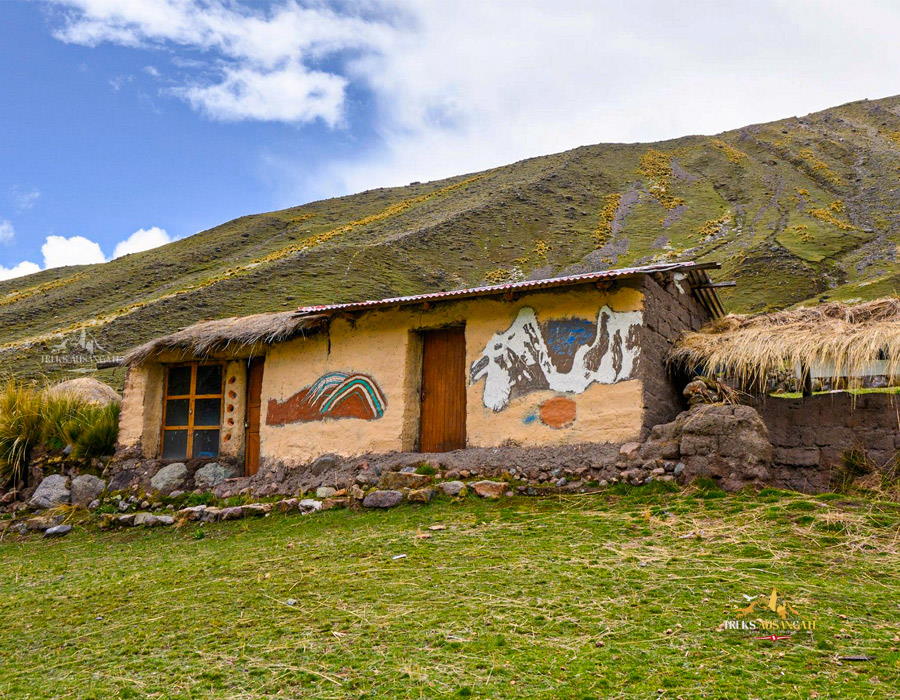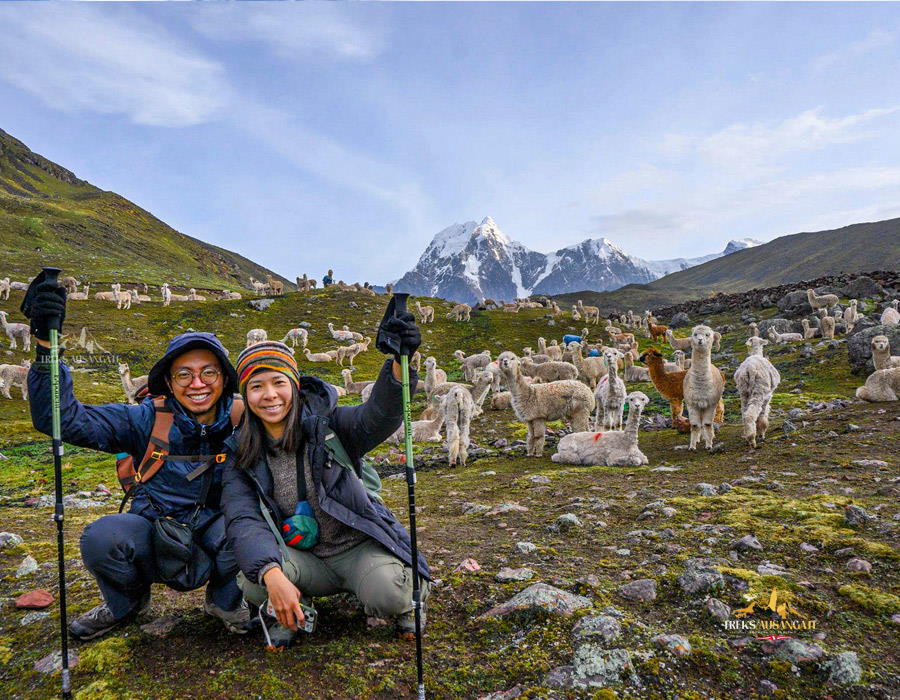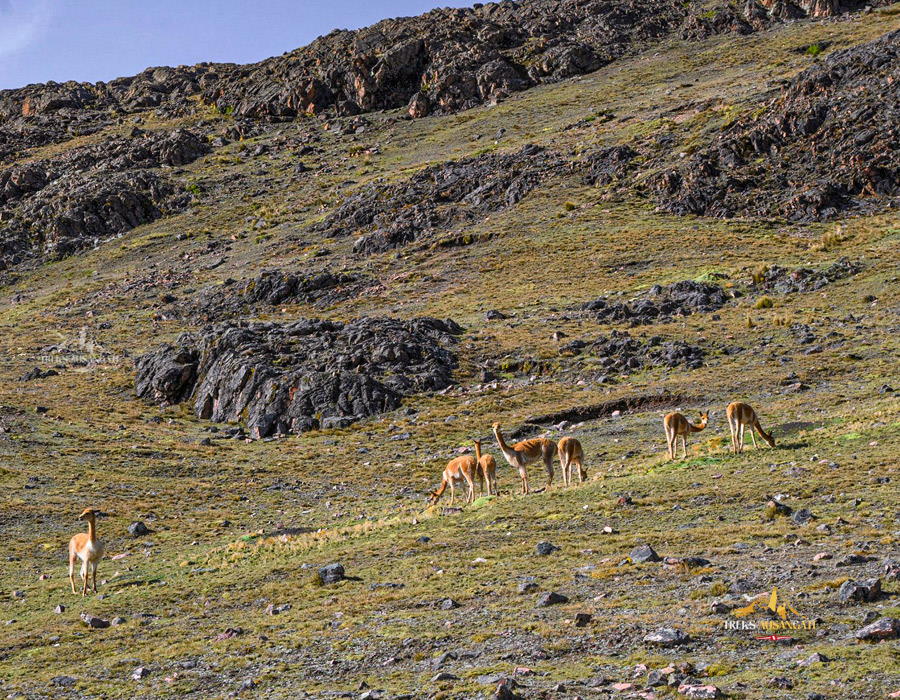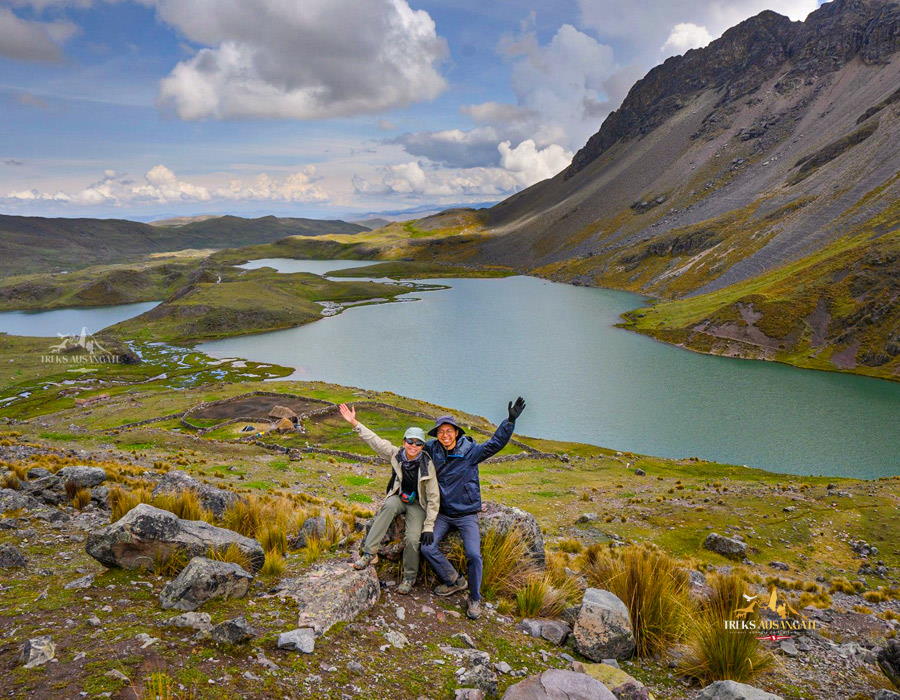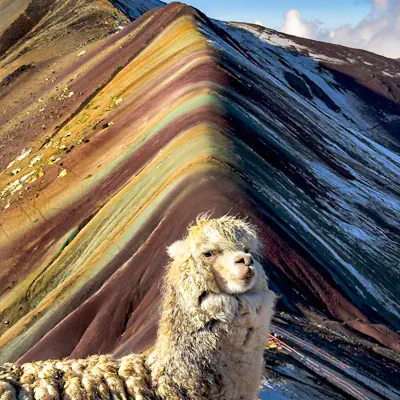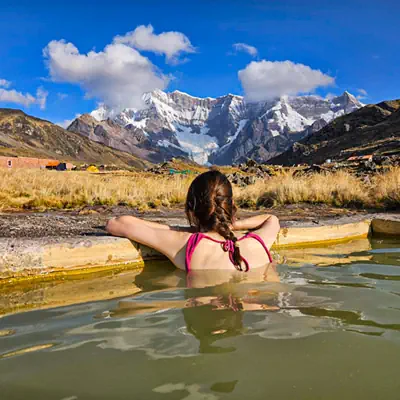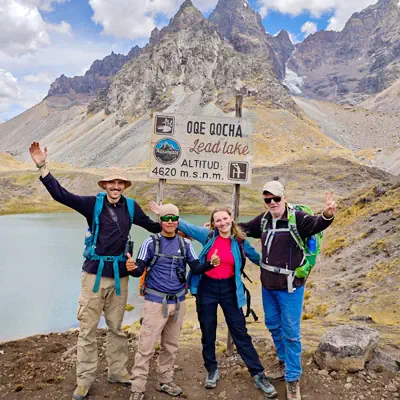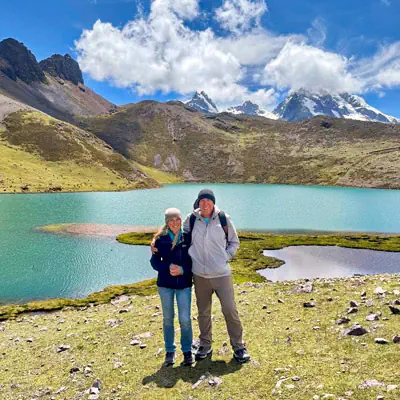Ausangate Trek 5 days / 4 nights Classic Route
The Ausangate Trek 5 days / 4 nights Classic route is an adventurous route offering stunning features such as spectacular mountain scenery, snow-capped peaks, hot springs, turquoise lakes, glaciers, herds of llamas, alpacas, and wild vicuña, chinchillas, a rare condor, picturesque villages, and traditionally dressed Quechua people. A trek where there are not many people , and what better to do this wonderful walk with us than we were born in Ausangate and know the best of our land.
This 5 days /4 nights Ausangate trek is at the beginning of the Vilcanota mountain range and traverses past the highest peak (Ausangate 6,385 m/20,948 ft) in the Cusco region. This adventurous trek is approximately 67 km/41.6 mi and goes up to 5,400 m/17,716 ft. It is moderate to challenging, not technical, with several high passes and often cold nights.
This beautiful five-day trek starts and finishes at the small Andean village of Tinqui and takes you around Ausangate mountain and over three high passes (two of them over 5,000 m/16,404 ft).
It is essential to be properly acclimatized for this hike, spending at least two or three days in Cusco (or equivalent altitude) before starting. The campsites are at high elevations and therefore will be quite cold in the evenings. Though it does not end in Machu Picchu, a train tour of Machu Picchu can easily be added to this (or any) trek. Minimum passengers necessary for trek departure: 2 people (1 person or private/custom treks possible with extra fee). Maximum trekkers per group: 10 people (special, private party groups can exceed the maximum).
Show more +Inclusions
What’s included
Not included
What to expect
Itinerary
Day 1: Cusco To Upis Camp
Your journey through the stunning Andean landscapes begins today when we pick you up very early from your accommodation at 5 am. We’ll travel in our private vehicle to the town of Ocongate (3,500 m / 11,482 ft). On the way, we’ll be able to see picturesque villages and beautiful lagoons along the Vilcanota Valley out the window.
We’ll continue to Tinke, where you can make any last-minute purchases before reaching the community of Upis (4,250 m / 13,944 ft), the starting point of our trek. We’ll enjoy a tasty breakfast here and meet the team of cooks and horsemen who’ll join us on our adventure.
Our first day begins on a plain-looking directly at the immense Ausangate glacier (6,372 m / 20,905 ft). As we walk, we’ll meet local people adorned in beautifully colorful traditional clothes. You’ll also spot lots of herds of llamas and alpacas.
We’ll arrive at the thermal baths of Upis (4,400 m / 14,436 ft) to enjoy our first spectacular lunch prepared by our talented chef. Our camp will also be set up here, right in front of Ausangate Mountain.
In the afternoon, we’ll walk to Huayna Ausangate lake and enjoy a stunning sunset that’ll cast its pretty light on the snows of the glaciers around us. In the evening, it’ll be time for a tasty dinner and our first night in the mountains.
- Accommodation: Camps
- MealsBox Breakfast, lunch, and dinner & snacks on the trail, and boiled water at lunch and camp.
- Difficulty: Moderate
- Minimum elevation: 4250m/13,944ft.
- Highest elevation: 4480m/14,698ft.
- Walking Distance: 8km/6.21mi.
- Walking time: 5 hours
- Campsite elevation: 4250 m/13,779 ft.
Day 2: Upis – Arapa Pass – Hatun Pukacocha
We will wake you up today with hot herbal tea of coca leaves in your tent to give you the energy boost you need to get going, after breakfast, we begin our second day of the hike.
You will hike very close to the Ausangate glacier peak and will have incredible views of this mountain as well as beautiful lakes and waterfalls. We may see some llamas, alpacas, wild vicuñas (the undomesticated ancestor of the alpaca), and perhaps a rare condor soaring above. We will have a 3-hour uphill hike to reach the first pass (4800m/15,748ft) where you will have magnificent views of the surrounding area. After taking a few amazing pictures we continue hiking gradually downhill for another 1½ hours to our beautiful lunch spot.
After lunch, we hike for another 2½ hours to arrive at our campsite at Puca Ccocha (Red Lake). This campsite is one of the most beautiful campsites located at the skirt of the Ausangate peak and the bank of the lake.
Later, we will explore the surrounding lagoons and relax with a delicious mate. In the evening, a nutritious dinner will be waiting for you. you will then head to spend a comfortable night at your campsite.
- Accommodation: Camps
- Meals: Breakfast, lunch, and dinner & snacks on the trail, boiled water at breakfast, lunch, and camp.
- Difficulty: Moderate
- Minimum elevation: 4250m/13,944ft.
- Highest elevation: 4800m/15,748ft.
- Walking Distance: 11km/6.84mi
- Walking time: 6 hours
- Campsite elevation: 4500 m/14,764 ft.
Day 3: Hatun Pukacocha -Ausangatecocha – Huchuy Finaya –Finayapampa
After breakfast, we leave camp at 7:00 am and walk for 2 hours approximately 3 hours to get to Ausangatecocha (4,300 m/14,107 ft,) which is at the bottom of one of the Ausangate glaciers. After enjoying the amazing view we climb steeply for 3 hours on a glacial moraine to the highest point on the trek, Palomani Pass 5,400 m/17,716 ft. From the pass, there are extensive views of all the peaks in the Cordillera Vilcanota. We then descend for 2 hours on a steep trail into the Huchuy Finaya Valley where we will stop for a quick lunch. From the valley and lunch stop, we will have a view of “Las Dos Gemelas” or the two twin mountains. We continue hiking for 1 hour on a varied path to our campsite in the Finayapampa Valley 4,300 m/14,107 ft. Happy hour at 4:00 pm and dinner at 6:00 pm.
- Accommodation: Camps
- Meals: Breakfast, lunch, and dinner & snacks on the trail, boiled water at breakfast, lunch, and camp.
- Difficulty: Challenging
- Minimum elevation: 4250m/13,944ft
- Highest elevation: 5400m/17,718ft
- Walking Distance: 16.25km/10.25mi
- Walking time: 8 hours
- Campsite elevation: 4500 m/14,764 ft
Day 4: Pinayapampa -Qampa – Ninaparayoc Camp
After breakfast, we leave camp at 7:00 am and begin climbing up to the Qampa pass (5,400 m/17,716 ft) for 3 hours. At this pass we have incredible views of The Three Peaks, and the Pacchanta Valley, and will hopefully get a glimpse of some wild vicuña and deer, and if we are really lucky a condor. We then descend gradually through the Pacchanta Valley, walking between Ausangate Mountain and the Two Twin Mountains for 2 hours until we stop for lunch. After lunch, we continue descending gradually on a rocky trail for another 2 1/2 hours to our campsite at Ninaparayoc camo (4,000 m/13,123 ft). From this campsite, we will have a great view of Ausangate Mountain. There is some lakes part of the 7 lagoons of Ausangate so we will explore some of them before having dinner.
- Accommodation: Camps
- Meals: Breakfast, lunch, and dinner & snacks on the trail, boiled water at breakfast, lunch, and camp.
- Difficulty: Moderate
- Minimum elevation: 4250m/13,944ft.
- Highest elevation: 4800m/15,748ft
- Walking Distance: 16.25km/10.25mi
- Walking time: 6 hours
- Campsite elevation: 4,000 m/13,123 ft.
Day 5: Ninaparayoc Camp -Pacchanta – Tinqui Village – Cusco
After breakfast, we walk for 3 hours on a varied and gentle trail Pacchanta Valley across open fields where we will have our final view of Ausangate, potato crops, and herds of llamas and alpacas. At Pacchanta we will have time to enjoy the hot springs and finally our last lunch with the Treks Ausangate team, meet our private transport and return to Cusco (3-hour drive), arriving around 5 or 6pm.
- Accommodation: None
- Meals: Breakfast, lunch & snacks on the trail, boiled water at breakfast
- DifficultyEasy
- Minimum elevation: 3800m/12,46ft.
- Highest elevation: 4250m/13,944ft.
- Walking Distance: 7km/4.35mi
- Walking time: 3 hours
Additional information
What to bring
Everything you need for the day should be kept in your daypack that you carry because all the items you leave with your porter will not be available to you until the evening at the campsite. It is recommended not to hike in cotton or jeans in the event of rain as cotton takes a very long time to dry. It is also recommended to bring true hiking boots or trail running shoes as regular running shoes do not get very good traction, especially when it has rained.
- Sleeping bags and walking poles (poles must have intact rubber bottoms) Recommend a sleeping bag rated for 20F/-7C or below for this trek.
- Sleeping bag liner (for your sleeping bag if you wish).
- Mattress pad – while we provide a mattress pad, being rested is essential for a great hiking experience and we find that sleep habits are very individualized. Therefore, we recommend bringing your own pad that you know you are comfortable sleeping on, as well as any other sleep items you might want to have (camp pillow, etc).
- Sunscreen: the sun is very strong in Cusco.
- Sun hat.
- Sunglasses.
- Lip balm.
- Hiking shoes/boots with good, grippy tread.
- Hiking pants (or shorts) and shirts (layers).
- Layers – long underwear and/or warm sleep pants for cold nights.
- Hand warmers if you wish.
- Warm hat, gloves, scarf and thick warm socks (or you can buy a traditional Peruvian hat and scarf – they are beautiful!).
- Daypack and rain cover.
- Rain gear – rain jacket and rain pants (optional for the pants), can buy an inexpensive poncho before the trek.
- Cash for tipping porters (USD or Peruvian Soles are fine), cooks, horsemen, guides, buying items along the trail, for in town, emergencies, etc. Note: Cash should be in perfect condition (ripped, damaged bills of any kind are NOT accepted anywhere in Peru).
- Swim suit, flip flops, towel for any hot springs you may visit (not every trek/trip has this) if you wish to go.
- Sandals.
- Torch/flashlight/headlamp (and batteries).
- Insect repellent if you visit Machu Picchu.
- Hand sanitizer and face covering (for COVID-19 Pandemic).
- Extra snacks if you wish (beyond snacks provided by us).
- E.g., if you have a favorite protein bar as Cusco doesn’t sell items like this.
- First aid kit, including blister protection (though your guide will have one, you may wish to carry one of your own).
- Personal medication and toiletries you might want/need.
- Camera, extra memory cards, batteries and solar panel/power bank.
- Water bottle or water bladder to refill.
- Passport (must be valid 6 months past your final travel dates for most countries).
- Copies of passport (keep copies separate, give to travel friends to keep, etc).
- Power plug adapter.
- Any medications you currently are taking or need/may need.
- Small quick-dry pack towels and/or compostable wipes for a quick wipe down at the end of the day.
Please note
When to go and degree of difficulty
March/April to November or the dry season. (Dec to Feb/March or wet season: rainfall and snow can block the pass and cancel the trek though we can arrange the trek during the wet season). This trek is rated as a moderate to challenging (intermediate to advanced) hike considering the high altitudes and length of walking especially on the 2nd Day. It is recommended that you acclimatize in Cusco for at least 3 days before trekking.
Weather on the trek and in Cusco
The weather varies a lot across Peru, having 28 climates and 84 of the world’s 104 ecosystems. Cusco is set high up (3,380 mts. 11,089 ft.) in the Andean Mountain Range and the dry season (winter) is from Mar/April to October/November with the wettest part of the year (summer) being December through March. The weather for trekking is pretty much the same year-round, with the main difference being the amount of rainfall. During the dry season, most days are dry and clear, but high-altitude mountains always have the potential for rain and/or snow so it is essential to come prepared for all types of weather regardless of the time of year.
The Rainbow trek
Is a very high altitude, therefore the weather can be quite cold and unpredictable. The nights on this trek are usually around 20F/-7C. During the day it can get quite warm if the sun is out; anywhere from 60-75F/15-24C. Keep in mind, if the weather is rainy or cloudy it will be colder, and the weather can change in an instant, particularly when up at the high-altitude passes. It is often quite windy at the top of the passes as well. As with any high-altitude trek you’ll need to bring plenty of layers to adjust to the fluctuating temperatures and conditions as well as appropriate sun/rain protection.
Cusco weather
Cusco is always very cold at night due to the high altitude. It is regularly around 40F/4.4C at night so bring a nice warm jacket for nighttime walking in town. It is warmer in Machu Picchu and the Sacred Valley and Aguas Calientes as these areas are at lower altitudes than Cusco and the trek.
The Departure point for the trek
Our meeting point to depart is at San Francisco Square at 05:30 am. There are fixed pickup points to help reduce time going to numerous hotels.
- If you are near Sol Avenue, Cultura Avenue or center of town be ready at 05:20 am.
- In any Hotel in San Blas please wait for us in front of the Church of San Blas for your transfer departing from 5.00 am.
- If you are at Loki Hostal, Niños Hotel, Meloc or Arcopata area please waits at the lobby of the hotel at 5.40 am.
- This information will be clarified by your guides at the briefing the night before the trek.
Left Luggage during your trek
It is best to leave extra luggage in your hotel in Cusco since you will arrive back around 8:00 pm on the 5th day.
Passport
Group tours are made up of different types of people. Physical conditions and ages caWe recommend that you bring your original passport.
Temperature
- Day temperatures vary from -7 to 22 degrees Celsius
- You must always use layering to manage the temperatures well. Night temperatures, (in the coldest season May to Sept) average -7 to -5 degrees Celsius.
Environmental issues
Please carry your personal rubbish to each campsite where the porters will pack it out. There are toilets at points along the trail and in campsites. At other points please leave the trail on the non-river side at least 30m and burn or bury toilet paper. Please encourage your group and staff to protect the environment.
Tips for the porters, cooks and guides and emergencies
We recommend considering $40-50 this is not mandatory but it is a tradition. You need to have your own money for bottled water or other drinks if wanted along the route. As for all American countries, tipping is common practice and is a part of the experience but not obligatory.
Generally, groups prepare a collective tip that is shared out between the porters, trekking crew and cooks on the third night. It is customary to thank the guides with a voluntary tip after the Tour in Ausangate on the fourth day. Please only use this information as a «guideline» requested by some trekkers but don`t let it cause you, or any other person in the group discomfort.
Travel Insurance
We strongly recommend that full Travel Insurance is taken, which includes cover, under certain circumstances, against the loss of deposit or cancellation charges. Please note that no reimbursements are given when cancellations occur or for any unused services.
Price
Price varies by group size. Click on the link to see our rates.
24/7 Assistance
We will contact you as soon as possible, approximately 10 minutes by WhatsApp and up to 5 hours by email.

